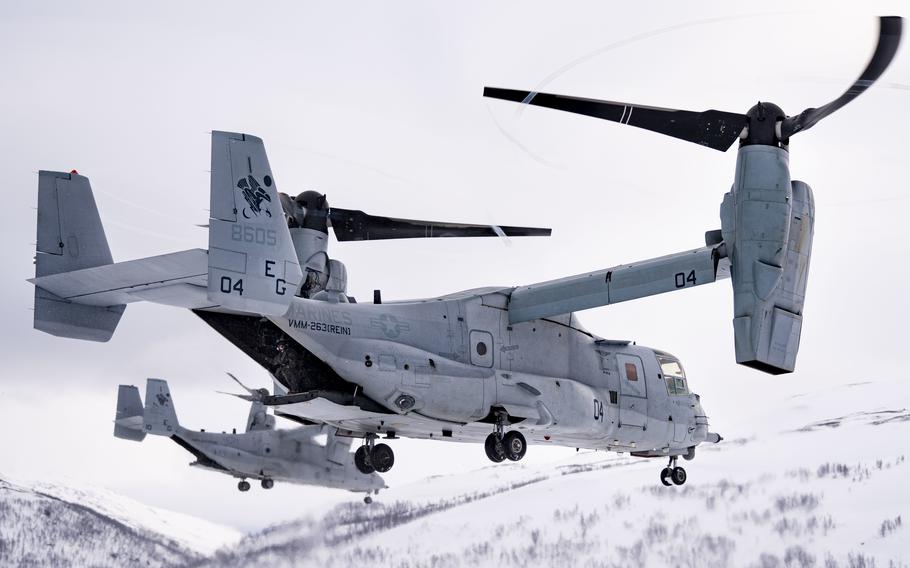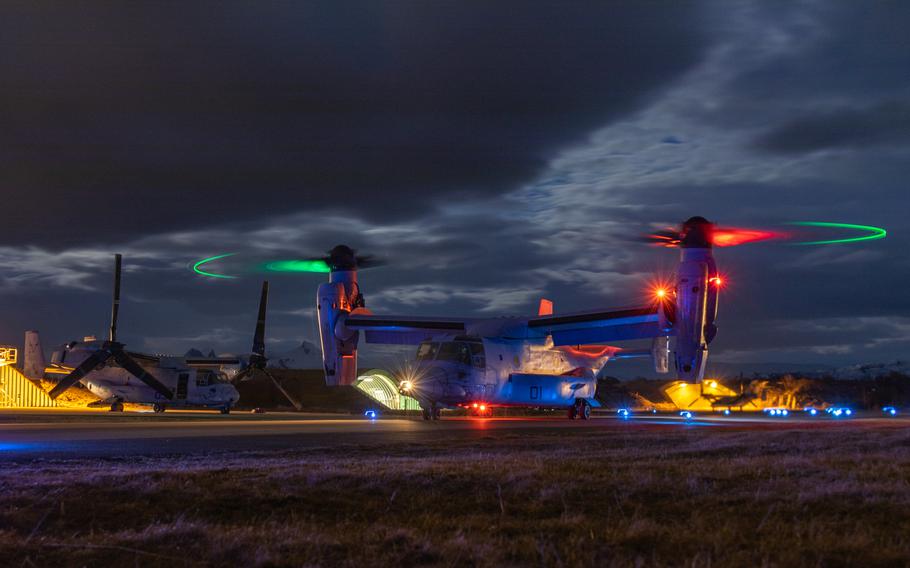
Two U.S. Marine Corps MV-22 Ospreys assigned to the Aviation Combat Element, 22nd Marine Expeditionary Unit, take off during an exercise in Bardufoss, Norway, on April 17, 2022. (Brittney Vella/U.S. Marine Corps)
Pilot error was the cause of an Osprey aircraft crash in Norway in March that killed four Marines, the service said in a statement.
The crash happened in the vicinity of Bodo, Norway, where thousands of troops were assembled for Exercise Cold Response.
The crew departed on an approved flight plan in clear conditions to the south of Bodo as their mission got underway, but the aircraft deviated from the preplanned route, the Corps’ investigation of the crash found.
The Osprey then entered the Gratadalen Valley, where it went down. The investigation concluded that the crash resulted from a series of faulty maneuvers conducted at a low altitude, the Marine Corps’ 2nd Marine Aircraft Wing said in the statement Monday.
Analysis of the recovered aircraft data showed that while in the valley, the Osprey made a left turn at 68 degrees angle of bank, followed by an overcorrected right turn of more than 80 degrees, the Marines said.

U.S. Marines prepare to take off in a MV-22B Osprey at Norwegian Air Force Base Bodo during Exercise Cold Response 22, Norway, March 16, 2022. Four Marines were killed in March when their Osprey crashed during the training exercise. (Elias Pimentel/U.S. Marine Corps)
Operating standards for the MV-22B Osprey for such a maneuver specify a limit of 60 degrees.
Marine Corps investigators examined and dismissed other potential contributing factors, such as weather and environmental conditions, adherence to predeployment training requirements and possible inexperience in mountainous environments.
The investigation could not determine which crew member was piloting the Osprey. The four Marines killed were Capt. Matthew Tomkiewicz, the aircraft commander; Capt. Ross Reynolds, the co-pilot; Gunnery Sgt. James Speedy, the aerial observer; and Cpl. Jacob Moore, the crew chief.
“Their loss continues to be felt across the Marine Corps, and our condolences remain with the family and friends of the fallen,” the Corps said in a statement.
In a separate crash in June, five Marines were killed when their Osprey crashed in California during training.
The hybrid Osprey, which takes off like a helicopter and can fly like a plane, has attracted criticism over safety concerns ever since it began replacing the CH-46 helicopter in the 2000s.
However, Navy and Marine Corps officials have repeatedly stated that the Osprey is fit to fly. The aircraft also played a key role for the Corps during the wars in Iraq and Afghanistan.